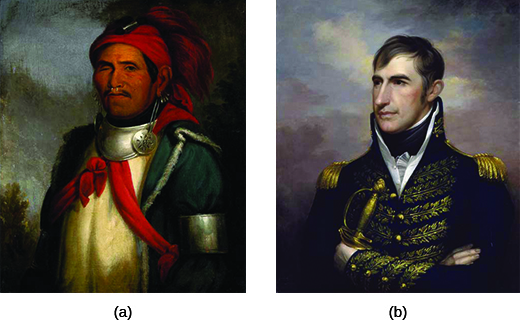| << Chapter < Page | Chapter >> Page > |
Another underlying cause of the War of 1812 was British support for native resistance to U.S. western expansion. For many years, white settlers in the American western territories had besieged the Indians living there. Under Jefferson, two Indian policies existed: forcing Indians to adopt American ways of agricultural life, or aggressively driving Indians into debt in order to force them to sell their lands.
In 1809, Tecumseh, a Shawnee war chief, rejuvenated the Western Confederacy. His brother, Tenskwatawa, was a prophet among the Shawnee who urged a revival of native ways and rejection of Anglo-American culture, including alcohol. In 1811, William Henry Harrison, the governor of the Indiana Territory, attempted to eliminate the native presence by attacking Prophetstown, a Shawnee settlement named in honor of Tenskwatawa. In the ensuing Battle of Tippecanoe, U.S. forces led by Harrison destroyed the settlement ( [link] ). They also found ample evidence that the British had supplied the Western Confederacy with weapons, despite the stipulations of earlier treaties.

The seizure of American ships and sailors, combined with the British support of Indian resistance, led to strident calls for war against Great Britain. The loudest came from the “war hawks,” led by Henry Clay from Kentucky and John C. Calhoun from South Carolina, who would not tolerate British insults to American honor. Opposition to the war came from Federalists, especially those in the Northeast, who knew war would disrupt the maritime trade on which they depended. In a narrow vote, Congress authorized the president to declare war against Britain in June 1812.
The war went very badly for the United States at first. In August 1812, the United States lost Detroit to the British and their Indian allies, including a force of one thousand men led by Tecumseh. By the end of the year, the British controlled half the Northwest. The following year, however, U.S. forces scored several victories. Captain Oliver Hazard Perry and his naval force defeated the British on Lake Erie. At the Battle of the Thames in Ontario, the United States defeated the British and their native allies, and Tecumseh was counted among the dead. Indian resistance began to ebb, opening the Indiana and Michigan territories for white settlement.
These victories could not turn the tide of the war, however. With the British gaining the upper hand during the Napoleonic Wars and Napoleon’s French army on the run, Great Britain now could divert skilled combat troops from Europe to fight in the United States. In July 1814, forty-five hundred hardened British soldiers sailed up the Chesapeake Bay and burned Washington, DC, to the ground, forcing President Madison and his wife to run for their lives ( [link] ). According to one report, they left behind a dinner the British officers ate. That summer, the British shelled Baltimore, hoping for another victory. However, they failed to dislodge the U.S. forces, whose survival of the bombardment inspired Francis Scott Key to write “The Star-Spangled Banner.”

Notification Switch
Would you like to follow the 'U.s. history' conversation and receive update notifications?